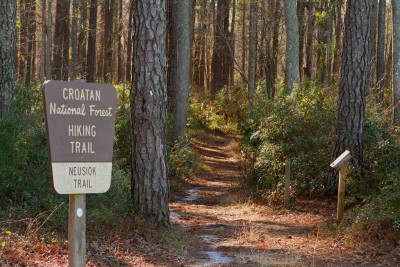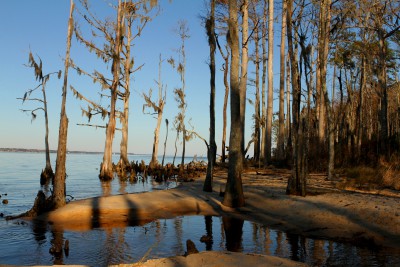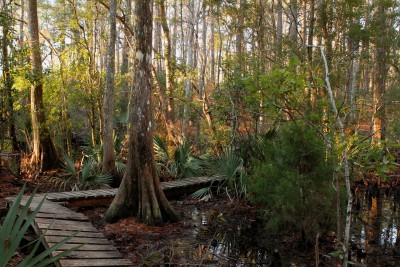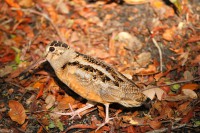
HAVELOCK — A thin, misty fog hung lightly on the air like a see-through chiffon curtain as I drove down an unpaved pothole-pocked road in the Croatan National Forest near this town in Craven County. On this chilly morning with the temperature just shy of freezing, I decided to do something I now wish I had done many years ago: hike the 21-mile-long Neusiok Trial.
As the gravel crunched under my running shoes, I made my way across the parking area at the Pine Cliff access area in search of the trailhead. Tucked in behind a few picnic shelters along the edge of the forest was a sign indicating the trail’s northern starting point. Just a few yards away, a woman walked her dog along the sandy, white beach shoreline of the Neuse River, an ancient two-million-year-old stretch of water that is the longest river in the state. Early English explorers in 1585 named the river after the native people, the Neusiok, who inhabited the lower section of the river. The word Neuse is one of the oldest English words still in use that was given to identify a place or area in the United States.
Supporter Spotlight
Due to the length of the trail and my desire to quickly complete the entire distance, I elected to jog rather than hike. I pulled on a small backpack stuffed with water, food and a camera and shuffled off past the trailhead sign and into the forest. A well-worn trail lay out before me, and I was soon meandering through a grove of towering pine trees. Even though I was in the forest, the trail was paralleling the river, offering great views of the river and its sandy beaches.

As the trail gained a little elevation I could look down on the river. The flow of the river, influenced by gravity, wind and storms, had scoured the bank creating 30-foot-high cliffs. Some trees teetered on the edge of the cliffs while others had already lost their balance in the fight with gravity. A jumbled boneyard of these trees was clustered in one area and a few had been sliced up with chainsaws to open up the trail. Fresh water seeping down from the small hills created wet areas with standing water that were dominated by cypress trees dripping with stringy gray Spanish moss.
The fog was now breaking up, creating a marbled mosaic of dull, white fog and powder-blue skies. Moisture in the fog had coated everything with a wet varnish, causing the knee-high grasses to bow heavily across the trail. As I ran past, they slapped my shins with a wet kiss and whipped into an upright posture as if released by a snare.
Away from the river, the trail eventually moved deeper into the rolling forest with ridges of hardwoods including beech and sweet gum. The trail was carpeted with the earth-tone colors of decaying leaves, and their organic aroma drifted into the air. But water was still close by as Cahooque and Hancock creeks could be seen through the trees from time to time. This area is reminiscent of Piedmont North Carolina with galax and mountain laurel scattered about.
This was once the haunt of moonshiners, who produced their potent, inebriating nectar in the isolation of the deep woods that today’s hikers find so alluring. Like the intoxicant brewed under these trees, the embrace of these woods and its earthy smells can revive even the dullest of spirits.
Supporter Spotlight

After about the first six miles, the trail leaves the higher hardwoods and becomes lower and wetter. For the next seven miles I was running through, depending on the topography and drainage patterns, longleaf pine savannas, stands of loblolly pine or wet pocosins with fetterbush and pond pines. The wet areas are made passable only by an incredible network of boardwalks. Some of the sections are as simple as a single plank laid directly on the ground while others are elevated on short pilings. The flooding and drainage in some areas are so strong that the boardwalks are firmly secured with strong cables to prevent them from being swept away. Sections of the boardwalk are identified with colorful names such as Toad Wallow and Cotton Mouth Spa, which I assume is a commentary from those who built the boardwalks.
Traveling along the wooden boardwalks, my footfalls were much quieter than when I was on the forest floor litter. Without the rustling of leaves or the snapping of twigs, the silent solitude of the woods was only interrupted by the call of birds. As one section of the boardwalk ended, I leaped back onto the trail, startling a dozen northern yellow-shafted flickers, causing them to launch from the grasses lining the trail and race to the safety of the trees. The boardwalks allowed me to quietly move along without being detected by the wildlife until I was right upon them.

Two other times I surprised animals when I left the boardwalk. First, a woodcock nearly smacked me in the face as it exploded into the sky when I almost stepped on it. Then a big mystery mammal went crashing through the shrubs causing me to run like a scalded dog for about a 100 yards before looking back. It was probably just a white-tailed deer, but the thought of an unexpected black bear kept me alert. Woodpeckers, however, dominated the day with downy, pileated and red-bellied woodpeckers plentiful. When I didn’t see them, I could usually hear one calling in the distance.
Around mile 13, the trail eventually opened up and deposited me on a packed-gravel forest service road. Initially this was a pleasant change from the forest trail, but within a quarter of a mile I was ready to return to the woods. After two miles on the sterile road, I was back in the bush soaking in the glory of the day. Ironically, however, I was soon wishing I was back on the smooth, dry and firm road. I was now getting a soaking of a different kind.
For the next three miles my run was reduced to a walk as I sloshed through large wet areas that flooded the trail. The main thing I remember from this soggy, boggy section was how cold my feet had become from the near freezing water. This section, however, would not be a big deal for a prepared hiker with waterproof boots. I passed a couple of backpackers heading in the opposite direction towards one of the three overnight shelters. They too appeared a bit wary of black bears with large bright red canisters of bear mace strapped to the front of their packs.
These hikers spent two days on the trail, which meanders for 21 miles along the Neuse River and through the Croatan National Forest.
Eventually this pocosin area gave way to a somewhat open pine forest. Here, the trail improved dramatically with sections of raised packed gravel. Now, I was back to running again with the feeling returning to my feet. I ran like a horse that smells the hay in the barn and picked up the pace for the final push to the trails end at Oyster Point on the Newport River. The sights and smells were now more familiar as I ran near the salt marshes of Mill Creek with live oaks overhead. Then, without warning, the trail came to an end at the Newport River.
This trail is now over 40 years old, being first laid out in 1971 by the ambitious Carteret County Wildlife Club. Members past and present have done a magnificent job clearing and marking the trail and building boardwalks. The rectangular, aluminum trail markers were numerous, making it difficult to get lost. This trail is so awesome that it has been incorporated into the prestigious 900-mile N.C. Mountain-to-Sea Trail.
With numerous road crossings, the Neusiok Trail is cut up in sections that can be hiked individually. The most popular being the northern six-mile Pine Cliff section. Jogging the trail was indeed a rigorous challenge, but I will return and hike each section independently to see what wonders I might have missed.








